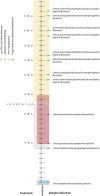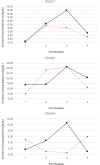Active Music Engagement and Cortisol as an Acute Stress Biomarker in Young Hematopoietic Stem Cell Transplant Patients and Caregivers: Results of a Single Case Design Pilot Study
- PMID: 33224077
- PMCID: PMC7667234
- DOI: 10.3389/fpsyg.2020.587871
Active Music Engagement and Cortisol as an Acute Stress Biomarker in Young Hematopoietic Stem Cell Transplant Patients and Caregivers: Results of a Single Case Design Pilot Study
Abstract
This paper reports the results of a single case design pilot study of a music therapy intervention [the Active Music Engagement (AME)] for young children (age 3.51 to 4.53 years) undergoing hematopoietic stem cell transplantation (HCST) and their caregivers. The primary aims of the study were to determine feasibility/acceptability of the AME intervention protocol and data collection in the context of HCST. Secondary aims were to examine caregivers' perceptions of the benefit of AME and whether there were changes in child and caregiver cortisol levels relative to the AME intervention. Results indicated that the AME could be implemented in this context and that data could be collected, though the collection of salivary cortisol may constitute an additional burden for families. Nevertheless, data that were collected suggest that families derive benefit from the AME, which underscores the need for devising innovative methods to understand the neurophysiological impacts of the AME.
Keywords: HPA axis (hypothalamus-pituitary-adrenal); HSCT; cortisol; hematopoietic (stem) cell transplantation (HCT); music therapy.
Copyright © 2020 Holochwost, Robb, Henley, Stegenga, Perkins, Russ, Jacob, Delgado, Haase and Krater.
Figures







Similar articles
-
Cortisol as an Acute Stress Biomarker in Young Hematopoietic Cell Transplant Patients/Caregivers: Active Music Engagement Protocol.J Altern Complement Med. 2020 May;26(5):424-434. doi: 10.1089/acm.2019.0413. Epub 2020 Feb 19. J Altern Complement Med. 2020. PMID: 32073877 Free PMC article.
-
Protocol and biomarker strategy for a multi-site randomized controlled trial examining biological mechanisms and dosing of active music engagement in children with acute lymphoblastic leukemia and lymphoma and parents.BMC Complement Med Ther. 2023 Mar 27;23(1):90. doi: 10.1186/s12906-023-03909-w. BMC Complement Med Ther. 2023. PMID: 36973774 Free PMC article.
-
Pilot Randomized Trial of Active Music Engagement Intervention Parent Delivery for Young Children With Cancer.J Pediatr Psychol. 2017 Mar 1;42(2):208-219. doi: 10.1093/jpepsy/jsw050. J Pediatr Psychol. 2017. PMID: 27289068 Free PMC article. Clinical Trial.
-
Psychosocial Influences on Acceptability and Feasibility of Salivary Cortisol Collection From Community Samples of Children.Res Nurs Health. 2016 Dec;39(6):449-462. doi: 10.1002/nur.21744. Epub 2016 Sep 30. Res Nurs Health. 2016. PMID: 27686043 Free PMC article. Review.
-
The Effect of Psychosocial Interventions on Outcomes for Caregivers of Hematopoietic Cell Transplant Patients.Curr Hematol Malig Rep. 2018 Jun;13(3):155-163. doi: 10.1007/s11899-018-0445-y. Curr Hematol Malig Rep. 2018. PMID: 29705880 Review.
Cited by
-
Revue exploratoire des interventions de soutien offertes aux membres de la famille d’un enfant subissant une greffe de cellules souches hématopoïétiques.Can Oncol Nurs J. 2023 Nov 1;33(4):426-435. doi: 10.5737/23688076334426. eCollection 2023 Fall. Can Oncol Nurs J. 2023. PMID: 38919595 Free PMC article. French.
-
A scoping review of integrated arts therapies and neuroscience research.Front Psychol. 2025 May 8;16:1569609. doi: 10.3389/fpsyg.2025.1569609. eCollection 2025. Front Psychol. 2025. PMID: 40406613 Free PMC article.
-
Characteristics and impacts of live music interventions on health and wellbeing for children, families, and health care professionals in paediatric hospitals: a scoping review.Int J Qual Stud Health Well-being. 2023 Dec;18(1):2180859. doi: 10.1080/17482631.2023.2180859. Int J Qual Stud Health Well-being. 2023. PMID: 36880806 Free PMC article.
-
Problem-Solving Skills Training for Parents of Children Undergoing Hematopoietic Stem Cell Transplantation: A Mixed Methods Feasibility Study.Cancers (Basel). 2025 Mar 10;17(6):930. doi: 10.3390/cancers17060930. Cancers (Basel). 2025. PMID: 40149268 Free PMC article.
-
Music Therapy for Children with Oncology & Hematological Conditions and Their Families: Advancing the Standards of Psychosocial Care.J Pediatr Hematol Oncol Nurs. 2022 Jan-Feb;39(1):49-59. doi: 10.1177/27527530211059726. J Pediatr Hematol Oncol Nurs. 2022. PMID: 35722869 Free PMC article.
References
Grants and funding
LinkOut - more resources
Full Text Sources

